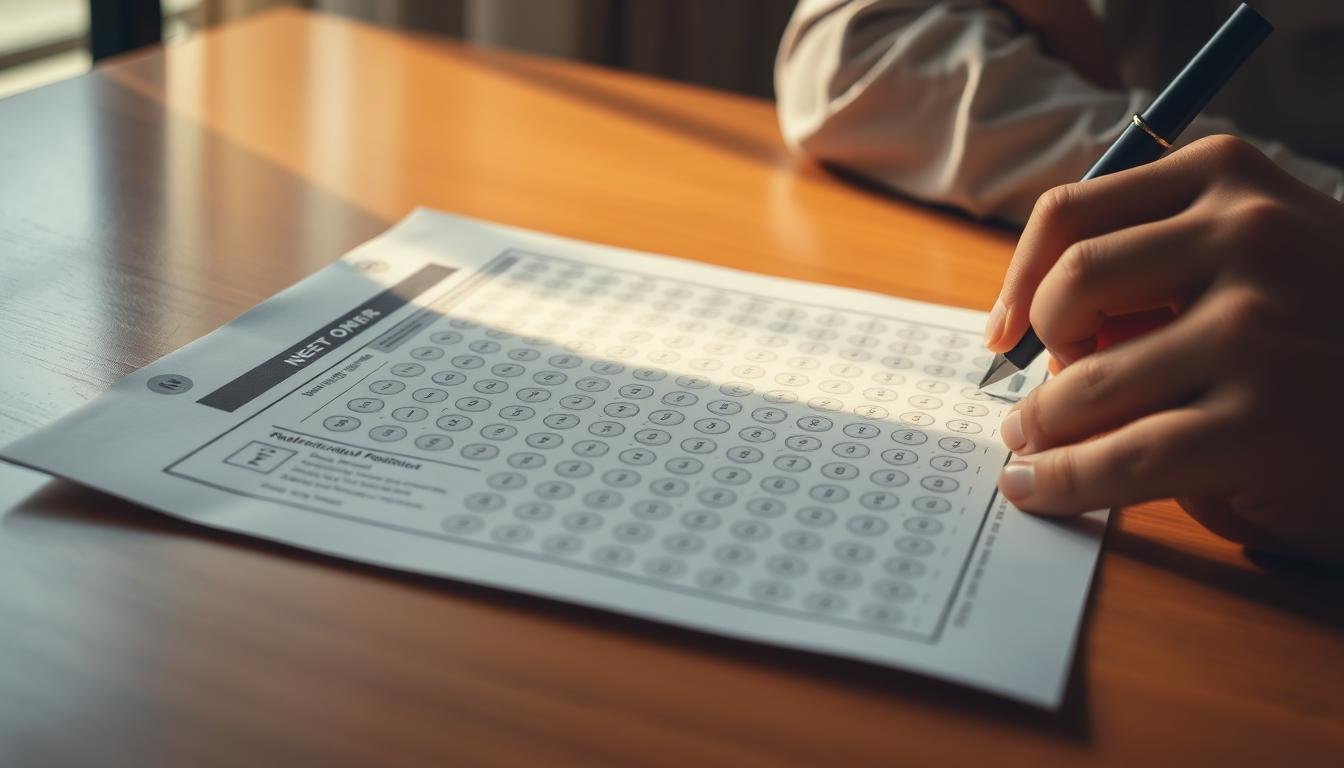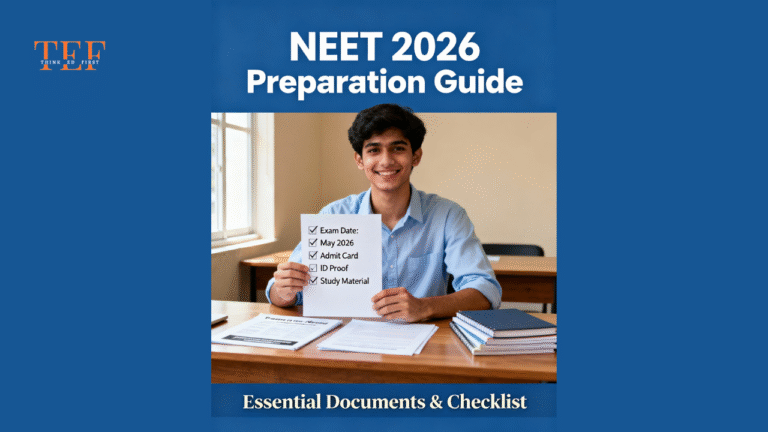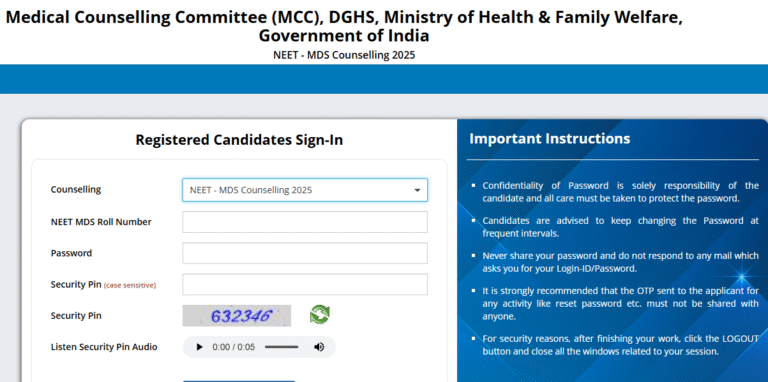Did you know that even the smallest error during your exam could cost you valuable marks? Many students underestimate the importance of correctly filling out their answer sheets, only to face unexpected consequences later. This guide is here to help you avoid those pitfalls.
We’ll walk you through the essential steps to ensure your answers are accurately evaluated. From using the right pen to entering details like your roll number correctly, every step matters. Mistakes like stray marks or multiple markings can lead to unnecessary deductions, impacting your final score.
By following our step-by-step advice, you can focus on what truly matters—your performance. Let’s make sure your hard work pays off without any avoidable errors.
Introduction to NEET OMR Sheet Filling
Precision in marking your answers can make or break your final score. The way you fill out your response sheet is just as important as the answers you choose. Even a small mistake can lead to unnecessary deductions, affecting your overall performance.
Why Accurate OMR Filling is Critical
Accuracy is crucial because the system relies on digital scanners to evaluate your responses. Stray marks or incomplete circles can lead to misread answers. This can result in losing marks you’ve worked hard to earn.
Common errors, like marking two options for a single question, are invalid and receive no score. Ensuring your details, such as your roll number, are correctly entered is equally important. These steps ensure your hard work is accurately reflected in your results.
Overview of NEET Exam Requirements
The exam requires candidates to use a blue or black ballpoint pen to darken circles completely. You must also enter your roll number and test booklet code correctly. These details are processed by advanced optical scanners, so precision is key.
Regular practice with sample sheets can help you avoid mistakes. Familiarity with the format reduces anxiety and improves speed. By following these guidelines, you can focus on answering questions confidently and accurately.
Understanding the NEET OMR Sheet Structure
The structure of the answer sheet plays a vital role in ensuring your responses are accurately evaluated. Each field has a specific purpose, and understanding its layout can help you avoid common errors. Let’s break down the key components and their importance.
Key Information Fields
The sheet includes several critical fields that must be filled accurately. These include your 10-digit roll number, 7-digit test booklet number, and personal details. Each of these fields helps verify your identity and link your responses to the correct exam records.
Answer bubbles are designed for computer scanning. Darkening them completely ensures the system reads your answers correctly. Stray marks or incomplete circles can lead to misread answers, affecting your score.
How the OMR Sheet is Processed by Computers
Advanced optical scanners evaluate the sheet by detecting the darkest marks in each bubble. These machines are highly accurate but rely on precise markings. Any pen marks outside the designated fields can interfere with the scanning process.
Matching the verification codes on both the sheet and the test booklet is crucial. This step ensures your responses are correctly linked to your exam records. Properly filling out the sheet protects the integrity of your results.
| Field | Purpose |
|---|---|
| Roll Number | Identifies the candidate uniquely. |
| Test Booklet Number | Links responses to the correct exam version. |
| Answer Bubbles | Records candidate responses for evaluation. |
| Verification Codes | Ensures accuracy in linking responses to records. |
Essential Guidelines for Filling the NEET OMR Sheet
Getting the details right can significantly impact your exam results. Every step in the process matters, from choosing the right tools to following instructions carefully. Let’s explore the key guidelines to ensure accuracy and avoid common mistakes.
Using Correct Instruments: Black or Blue Ballpoint Pens
One of the most critical steps is using the right pen. Only black or blue ballpoint pens are allowed. Pencils or gel pens can lead to misread answers by the scanning system. This simple choice ensures your responses are accurately evaluated.
Make sure to darken the answer bubbles completely. Partial fills or light marks can confuse the scanner, resulting in lost marks. Taking the time to do this correctly is essential for success.
Reading and Following Instructions Carefully
Before starting, read all instructions on the sheet thoroughly. Each student must enter details like the roll number and test booklet code accurately. These steps ensure your responses are linked to the correct exam records.
Common mistakes include marking extra fields or skipping instructions. Setting aside time to verify each step can prevent these errors. Proper preparation helps you focus on answering questions confidently.
| Guideline | Importance |
|---|---|
| Use black or blue ballpoint pens | Ensures accurate scanning of responses. |
| Darken bubbles completely | Prevents misreads by the scanner. |
| Read instructions carefully | Avoids common errors and ensures compliance. |
| Verify details before starting | Links responses to the correct exam records. |
Step-by-Step Process for NEET OMR Sheet Filling
A well-prepared approach to marking your responses can save you from unnecessary stress and errors. This section outlines a clear process to ensure accuracy and confidence during the exam. Let’s break it down into manageable steps.
Before the Exam: Preparation and Mindset
Start by verifying your roll number and test booklet code. These details are crucial for linking your responses to the correct records. Ensure you have all necessary information written clearly to avoid last-minute confusion.
Adopt a calm and focused mindset. Practice time management techniques to allocate sufficient time for each question. Familiarize yourself with the exam format and marking scheme to reduce anxiety.
On Exam Day: Marking Answers Effectively
Begin by carefully reading all instructions on the paper. Double-check pre-filled details like your roll number and test booklet code to ensure accuracy. This step prevents processing errors later.
When marking answers, use a black or blue ballpoint pen. Darken the answer bubbles completely to avoid misreads by the scanner. Avoid stray marks or over-marking, as these can lead to lost marks.
Review your answer key before submission. This ensures all responses are correctly marked and aligns with your intended answers. Taking these steps helps protect your hard work and ensures accurate results.
| Step | Action |
|---|---|
| Pre-Exam | Verify roll number and test booklet code. |
| Mindset | Practice time management and stay calm. |
| Exam Day | Read instructions and check pre-filled details. |
| Marking | Use the correct pen and darken bubbles completely. |
| Review | Double-check answers before submission. |
Tips to Avoid Common OMR Filling Mistakes
Small mistakes in marking can lead to big consequences during the evaluation process. Ensuring accuracy in your responses is essential to avoid losing valuable marks. Here’s how you can prevent common errors and ensure flawless sheet filling.
Preventing Incomplete or Stray Marks
Incomplete or faint marks can confuse the scanning system, leading to misread answers. Always use a black or blue ballpoint pen and darken the bubbles completely. This ensures your responses are accurately recorded.
Avoid stray marks outside the designated fields. These can interfere with the scanning process and result in lost marks. Take your time to mark each answer carefully and review your work before submission.
Avoiding Multiple Markings on One Question
Marking more than one bubble for a single question invalidates your response. Ensure you choose only one correct answer and darken the corresponding bubble fully. Double-check your selections to avoid this common mistake.
If you change your answer, erase the previous mark completely. Overlapping marks can confuse the scanner and lead to incorrect evaluation. Practicing with sample sheets can help you develop precision and confidence.
By following these tips, you can minimize errors and ensure your hard work is accurately reflected in your results. For more strategies on effective time management, explore our detailed guide.
Filling the “neet omr sheet filling” Accurately
Accuracy in marking your responses ensures your hard work is accurately evaluated. Even minor errors can lead to significant consequences, such as misread answers or lost marks. Understanding the marking protocols is essential to avoid these pitfalls.
Understanding the Marking Protocols
Each bubble on the sheet must be filled uniformly and precisely. Darkening the circles completely ensures the scanning system reads your answers correctly. Stray marks or incomplete fills can confuse the machine, leading to errors.
Using the designated pen types, such as black or blue ballpoint pens, enhances the clarity of marks. Gel pens or pencils are not recommended, as they can cause scanning issues. This simple step ensures your responses are accurately recorded.
Role of Key Details
Entering details like your roll number and test booklet code correctly is crucial. These fields link your responses to the correct exam records. Any discrepancy in these details can lead to processing errors.
If you notice any discrepancies, such as pre-filled errors, inform the invigilator immediately. Addressing these issues promptly ensures your answers are correctly associated with your exam records.
Correct vs. Incorrect Marking Techniques
Practicing with sample sheets can help you develop precision. Compare different marking scenarios to understand the correct techniques. For example, darkening one bubble fully is correct, while overlapping marks or partial fills are incorrect.
Experts recommend maintaining consistency in marking. Double-checking your work before submission reduces the error rate significantly. This practice ensures your hard work is accurately reflected in your results.
| Marking Technique | Outcome |
|---|---|
| Darken one bubble fully | Correct response |
| Overlapping marks | Incorrect response |
| Partial fills | Misread by scanner |
| Stray marks | Processing error |
How to Verify Your OMR Response Post-Exam
Post-exam verification is essential to confirm your responses are accurately evaluated. A careful review of your response sheet ensures your hard work translates into the correct score. Here’s a step-by-step guide to help you through the process.
Downloading the Response Sheet from Official Website
After the exam, candidates must download their scanned response sheet from the official NTA website. This sheet contains all your marked answers and details. Follow these steps to access it:
- Log in to the official NEET portal using your credentials.
- Navigate to the “Response Sheet” section and download the file.
- Save the document for future reference and verification.
Checking for Registration and Code Errors
Once you have the sheet, verify all details to ensure accuracy. Look for discrepancies in your registration information and question paper code. Here’s a checklist to guide you:
- Confirm your roll number and name match the registered details.
- Check the test booklet code for consistency with your question paper.
- Ensure all answer bubbles are correctly marked and free from stray marks.
- Report any errors or mismatches to the authorities immediately.
Careful verification is critical for an accurate estimation of your score. By following these steps, you can ensure your responses are correctly recorded and evaluated.
Challenging Incorrect OMR Entries
Challenging discrepancies in your answer sheet is a crucial step to ensure fairness. Even after careful verification, errors can occur. Fortunately, candidates have the option to address these issues through a formal process.
Steps to Challenge Your OMR Sheet
If you spot an error in your marked responses, follow these steps to raise a challenge:
- Log in to the official exam portal using your credentials.
- Navigate to the challenge section and select the question you wish to dispute.
- Provide the correct answer and submit your request through the portal.
This process ensures your concerns are reviewed by the authorities. Always double-check the details before submitting your challenge.
Fees and Deadlines for OMR Challenges
Challenging a question involves a non-refundable fee of ₹200 per question. Candidates must adhere to the specified deadlines to ensure their requests are processed. Missing the deadline can result in the challenge being disregarded.
Common mistakes, such as incomplete circles or incorrect markings, can be rectified through this process. Immediate action is essential to protect your hard work and ensure accurate results.
Important Dates and Exam-Related Information
Staying updated with exam-related dates ensures you don’t miss critical deadlines. Knowing when to expect key communications helps you prepare effectively and avoid last-minute issues. Here’s a detailed timeline to guide you through the process.
Exam Day and OMR Sheet Release Dates
The exam is scheduled for May 4, 2025. Admit cards will be available by May 1, 2025. After the exam, the OMR sheet will be released in the first week of June 2025. These dates are crucial for planning your preparation and follow-up activities.
Timeline for Answer Key and Challenges
The provisional answer key will be released in the last week of May 2025. Candidates can challenge discrepancies in the first week of June 2025. The final answer key will be published in the second week of June 2025. Results are expected by the third week of June 2025.
Using the correct ballpoint pen is essential throughout the exam process. Ensure you follow the marking pattern carefully to avoid errors. Here’s a summary of the key dates:
| Event | Date |
|---|---|
| Exam Date | May 4, 2025 |
| Admit Card Release | May 1, 2025 |
| OMR Sheet Release | First Week of June 2025 |
| Provisional Answer Key | Last Week of May 2025 |
| Challenge Window | First Week of June 2025 |
| Final Answer Key | Second Week of June 2025 |
| Result Declaration | Third Week of June 2025 |
Stay updated with official notifications to ensure you don’t miss any deadlines. Proper planning and adherence to the timeline will help you manage the exam cycle effectively.
NEET Exam Pattern and Answer Marking Scheme
Understanding the exam structure and marking scheme is key to maximizing your score. The examination is divided into four subjects: Physics, Chemistry, Botany, and Zoology. Each subject has two sections, with a total of 200 questions. However, candidates must answer only 180 questions to complete the test.
Sectional Breakdown of the Exam
The examination is structured to test your knowledge across multiple subjects. Section A contains 35 questions per subject, while Section B has 15 questions. Here’s a quick breakdown:
- Physics: 35 (Section A) + 15 (Section B) = 50 questions
- Chemistry: 35 (Section A) + 15 (Section B) = 50 questions
- Biology (Botany and Zoology): 50 + 50 = 100 questions
Focusing on each subject equally can help you score well.
Understanding the Negative Marking System
Negative marking is a critical aspect of the examination. Each correct answer awards 4 marks, while an incorrect one deducts 1 mark. Unanswered questions do not affect your score. Here’s how it works:
- Correct answer: +4 marks
- Incorrect answer: -1 mark
- Unanswered question: 0 marks
Carefully filling each bubble is essential to avoid losing marks. Stray marks or multiple markings can lead to penalties, so practice precision during your preparation.
By understanding the exam pattern and marking scheme, you can approach the test with confidence and clarity. Make sure to download your admit card early to avoid last-minute issues.
Resources and Expert Recommendations for Aspirants
Success in the exam depends on more than just knowledge; it’s about using the right resources. Access to quality study materials and expert guidance can significantly boost your preparation. We’ve curated a list of recommended videos, study materials, and tips to help you excel.
Recommended Videos and Study Materials
High-quality resources are essential for mastering subjects like Physics and Chemistry. Platforms like Aakash and BYJU’S offer curated videos and study materials tailored for exam preparation. These resources simplify complex concepts and provide practice questions to enhance your understanding.
Using a black or blue ballpoint pen for practice ensures consistency with exam requirements. Regular practice with these materials helps you avoid common mistakes and adopt correct marking techniques.
Expert Tips from Coaching Centers
Leading coaching centers emphasize the importance of a structured study plan. Experts recommend dedicating specific hours to each subject, focusing on weak areas, and revising regularly. Clear declaration of study schedules can enhance preparation efficiency.
Here’s a summary of expert tips and resources:
| Resource | Benefit |
|---|---|
| Curated Videos | Simplify complex topics in Physics and Chemistry. |
| Practice Questions | Enhance problem-solving skills and accuracy. |
| Study Plans | Provide a structured approach to preparation. |
| Expert Guidance | Offer strategies to avoid common pitfalls. |
Integrating these resources into your daily routine can make a significant difference. Focus on quality over quantity, and ensure your preparation aligns with exam requirements.
Additional Strategies for Exam Success
Effective time management can be the difference between success and stress during the exam. Allocating specific time slots for each section ensures you answer all questions without rushing. Start with easier questions to build confidence and save time for challenging ones.
Plan to review your responses before submission. Double-check details like your roll number and test booklet code to avoid errors. This step ensures your hard work is accurately reflected in your results.
Stay calm and focused, even under pressure. Deep breathing techniques can help maintain clarity. By combining these strategies with proper preparation, you can maximize your performance and achieve your goals.





